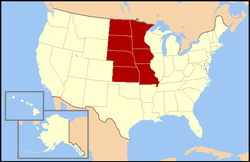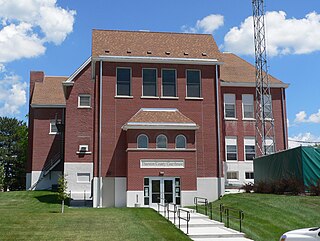
Thurston County is a county in the U.S. state of Nebraska. As of the 2020 United States Census, the population was 6,773. Its county seat is Pender.

Atchison County is the northwesternmost county in the U.S. state of Missouri. As of the 2020 census, the county had a population of 5,305. Its county seat is Rock Port. It was originally known as Allen County when it was detached from Holt County in 1843. The county was officially organized on February 14, 1845, and named for U.S. Senator David Rice Atchison from Missouri.

Doniphan County is the most northeastern county in the U.S. state of Kansas. Its county seat is Troy, and its most populous city is Wathena. As of the 2020 census, the county population was 7,510. The county was named after Alexander Doniphan, a Mexican–American War hero. It is bounded on the east by the Missouri river, south by Atchison county, and west by Brown county.

The Midwestern United States, also referred to as the Midwest or the American Midwest, is one of four census regions of the United States Census Bureau. It occupies the northern central part of the United States. It was officially named the North Central Region by the U.S. Census Bureau until 1984. It is between the Northeastern United States and the Western United States, with Canada to the north and the Southern United States to the south.

In American politics, a swing state is any state that could reasonably be won by either the Democratic or Republican candidate in a statewide election, most often referring to presidential elections, by a swing in votes. These states are usually targeted by both major-party campaigns, especially in competitive elections. Meanwhile, the states that regularly lean to a single party are known as "safe states", as it is generally assumed that one candidate has a base of support from which a sufficient share of the electorate can be drawn without significant investment or effort by the campaign.
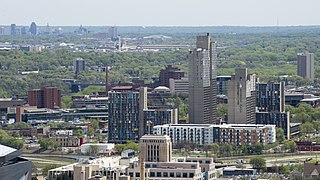
The Upper Midwest is a region in the northern portion of the U.S. Census Bureau's Midwestern United States. It is largely a sub-region of the Midwest. Although the exact boundaries are not uniformly agreed-upon, the region is usually defined to include the states of Michigan, Minnesota and Wisconsin; some definitions include Iowa, North Dakota, South Dakota, and parts of Nebraska and Montana as well.
The Democratic Senatorial Campaign Committee (DSCC) is the Democratic Hill committee for the United States Senate. It is the only organization solely dedicated to electing Democrats to the United States Senate. The DSCC's current Chair is Senator Gary Peters of Michigan, who succeeded Nevada‘s Catherine Cortez Masto after the 2020 Senate elections. DSCC's current executive director is Christie Roberts.

Political party strength in U.S. states is the level of representation of the various political parties in the United States in each statewide elective office providing legislators to the state and to the U.S. Congress and electing the executives at the state and national level.
Electoral-vote.com is a website created by computer scientist Andrew S. Tanenbaum. The site's primary content was originally poll analysis to project election outcomes. Since the 2016 elections, the site also has featured daily commentary on political news stories.
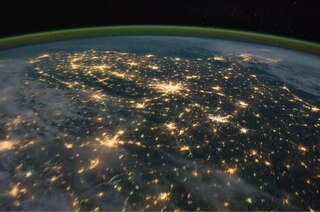
The Central United States is sometimes conceived as between the Eastern and Western as part of a three-region model, roughly coincident with the U.S. Census's definition of the Midwestern United States plus the western and central portions of the U.S. Census's definition of the Southern United States. The Central States are typically considered to consist of North Dakota, South Dakota, Nebraska, Kansas, Oklahoma, Texas, Minnesota, Iowa, Missouri, Arkansas, Louisiana, Wisconsin, Illinois, Michigan, Indiana, Ohio, Kentucky, Tennessee, West Virginia, Mississippi and Alabama.
The Rotating Regional Primary System is a proposed system for reform of the United States presidential primary process, in which the country would be divided into four regions for primary elections. The plan has been promoted since 1999 by the National Association of Secretaries of State.

The heartland, when referring to a cultural region of the United States, is the central land area of the country, usually the Midwestern United States or the states that do not border the Atlantic or Pacific oceans, associated with mainstream or traditional values, such as economic self-sufficiency, conservative political and religious ideals, and rootedness in agrarian life.

The 1984 United States presidential election in North Dakota took place on November 6, 1984. All 50 states and the District of Columbia, were part of the 1984 United States presidential election. State voters chose three electors to the Electoral College, which selected the president and vice president of the United States. North Dakota was won by incumbent United States President Ronald Reagan of California, who was running against former Vice President Walter Mondale of Minnesota. Reagan ran for a second time with former C.I.A. Director George H. W. Bush of Texas, and Mondale ran with Representative Geraldine Ferraro of New York, the first major female candidate for the vice presidency.

The "Blue wall" is a term used by political pundits to refer to eighteen U.S. states and the District of Columbia that the Democratic Party won in each presidential election from 1992 to 2012. George W. Bush, the only Republican president elected during this time, was able to narrowly win the electoral college in 2000 and 2004 only by winning states outside of the blue wall, enough to defeat his Democratic opponents, Al Gore and John Kerry, respectively.

Presidential primaries and caucuses of the Republican Party took place in many U.S. states, the District of Columbia, and five U.S. territories from February 3 to August 11, 2020, to elect most of the 2,550 delegates to send to the Republican National Convention. Delegates to the national convention in other states were elected by the respective state party organizations. The delegates to the national convention voted on the first ballot to select Donald Trump as the Republican Party's nominee for president of the United States in the 2020 election, and selected Mike Pence as the vice-presidential nominee.
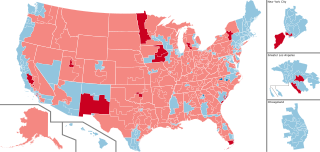
The 2020 United States House of Representatives elections were held on November 3, 2020, to elect representatives from all 435 congressional districts across each of the 50 U.S. states to the 117th United States Congress, as well as six non-voting delegates from the District of Columbia and the inhabited U.S. territories. Special House elections were also held on various dates throughout 2020.

Below is a detailed tally of the results of the 2020 Republican Party presidential primary elections in the United States. In most U.S. states outside New Hampshire, votes for write-in candidates remain untallied.
This is a tentative timeline of major events leading up to, during, and after the 2024 United States presidential election. This will be the first presidential election to be run with population data from the 2020 census. In addition to the dates mandated by the relevant federal laws such as those in the U.S. Constitution and the Electoral Count Act, several milestones have consistently been observed since the adoption of the conclusions of the 1971 McGovern–Fraser Commission.

The 119th United States Congress is the next meeting of the legislative branch of the United States federal government, composed of the United States Senate and the United States House of Representatives. It is scheduled to meet in Washington, D.C., from January 3, 2025, to January 3, 2027, during the final weeks of Joe Biden's term, and the first two years of Donald Trump's second presidential term. The elections of November 2024 will decide control of both houses.
